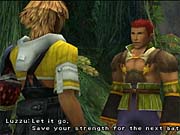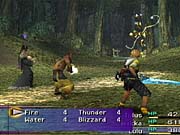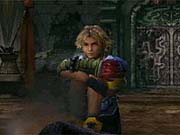Final Fantasy X Updated Preview
We take a look at a previewable English version of the latest Final Fantasy game.

We recently received an 80-percent-complete version of Final Fantasy X and have managed to plow through many of the game's early sequences. Being the first Final Fantasy game to be set in a fully polygonal world, as well as feature an entirely voiced script, it's definitely the most lavishly produced game yet in the series. Still, while there are some notable changes to many of its systems, there are just as many that hearken back to the series' simpler past.
Like many of the games before it, Final Fantasy X takes place in a series of unique settings. Without spoiling too much of the game's exposition, Tidus, the main character, is part of a fairly advanced culture, centered in an area called Zanarkand--advanced enough, at any rate, to have among its favored pastimes "blitzball," a game that revolves around spheres of gravitationally suspended water and nigh-amphibious athletes. Tidus himself is a blitzball star, renowned throughout his homeland. He's on his way to a match at the game's outset, one that is indeed ill-fated. That very day, as it happens, is when Sin--the game's antagonist and an altogether catastrophic force of nature--decides to raze Zanarkand. After several harrowing sequences, and thanks to the intervention of a mysterious acquaintance, Tidus manages to survive the horrific attack. But as a result, he emerges in an altogether foreign world.
It is in this new world that Tidus meets all of his future friends--Yuna, Wakka, Rikku, Lulu, and Kimahri, among others. As this world is in a more primitive state than Tidus' own, the fact that water makes up a large portion of its landmass is much more apparent--no flowing skyscrapers block the view's boundless ocean. When it comes to actual game environments, Final Fantasy X's tend to be a bit more compact than previous ones. There's a pretty staggering amount of real-time detail worked into each area, so the need is understandable. Still, even during our early explorations, we came across some pretty expansive zones, though the level of detail dropped proportionally to the square footage. To aid in the navigation of these areas, Square has thoughtfully worked onscreen maps into each, all of which are conveniently marked with entrance- and exit zones. Structures that you can enter are similarly mapped.

With respect to the tradition established by each previous installment, Final Fantasy X enjoys a reworked combat system. There are a handful of relatively radical changes, the most obvious of which to fans of recent installments is the absence of an active-time system. For the first time in a good while, battles in Final Fantasy are now entirely turn-based, thus allowing you the leisure of plotting your actions without the need to worry about a constant barrage of enemy attacks. You're also able to swap party members in and out of combat during battles, and doing so is a free action. If you've encountered a monster that's susceptible to a certain type of magical attack, for instance, you can swap in Lulu (your resident black mage) to make easy work of it--all without costing you a turn in battle. Adding to the subtle strategic element is an onscreen turn counter, which displays portraits of those who are up for action. Overall, battles feel more fast paced than previous ones; each attack is accompanied by much less of a "windup," and the animations are bustier overall. Even magic spells (outside of summons, anyway) seem to be resolved fairly quickly. This brisk pace is quite welcome, especially in light of the lengthy (and quite frequent) cutscenes that pepper the game.

A modern Final Fantasy game wouldn't be deserving of its title if it weren't populated by a host of cutscenes. Final Fantasy X is no different. Its heavy-handed narrative is presented by means of cutscenes, both real-time and prerendered, and, as you'd expect, their quality is genre defining. While the game's graphical production seems notably less impressive now than it did when we all first saw it, it's still easily head and shoulders above that of any RPG we've seen so far. The world crafted herein is marvelous from a design standpoint--the flowing cityscapes and narrow bridges of Zanarkand are quite a pleasure to behold, and the idyllic serenity of Yuna's homeland is almost tangible. When you watch the blitzball sequences during one the game's early prerendered cinematics, you'll agree that there are some very inspired visual designers within Square's army of artists. What's perhaps more impressive, though, is how seamlessly the game transitions from real-time to prerendered--the switches are often made during momentary lulls in especially charged moments, which nearly hides the shift. The prerendered cutscenes are untouchable, and real-time sequences are impressive in their own right. Though you'll often notice a bit of polygonal funk--slight, slight "shake," and such--to nitpick is pointless. Some people feel that heavy cinematics are anathema to compelling game design. Others maintain that narrative--dealt in heavy, unskipable doses--gives games "depth." If you count yourself among the latter, then you'll probably be very happy with Final Fantasy X's presentation.

During these sequences, in any event, your characters will actually talk--a first for a Final Fantasy game. Every line spoken by any of the important characters in the story is voiced, for better or worse, and the build we've recently received marks the first time a Final Fantasy game character has spoken English. Each character has a distinct and, for the most part, fairly well-thought-out vocal identity. Tidus sounds like the young, scrappy, good-natured protagonist he is; his vocabulary heavily incorporates the word "cool," and his tone is brash, youthful, and enthusiastic. During scenes in which he's narrating from the future, however, his voice sounds markedly world-weary and weathered. Wakka speaks with a Caribbean accent, as do most of his countrymen. Lulu's voice is cold and husky, complementing her characteristic creepy cool. Yuna's is expectedly soft and gentle, and Rikku's is curious and abrupt. As for Kimahri, well, we've yet to hear him utter a word.
The voice work, for the most part, is decent, though certain characters' voices tend to grate--voice production seems to be that type of hit-and-miss affair. The fact that the characters are actually talking, however, should be suitably exciting to fans of the series. We'll have to play the game a bit more before making any more conclusive statements. Somewhere in between Shenmue and Metal Gear Solid would characterize the production well. No one here was terribly offended, though some chuckles were heard.
In any event, enjoy the media barrage that accompanies this preview and expect an update as soon as developments warrant. Final Fantasy X seems like it's definitely shaping up to be the lovingly produced, aptly upgraded RPG that everyone is expecting it to be. The game is due out this January. We'll let you know if this changes.
Got a news tip or want to contact us directly? Email news@gamespot.com
Join the conversation